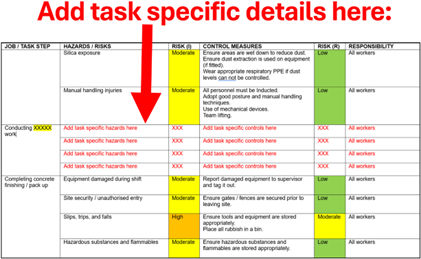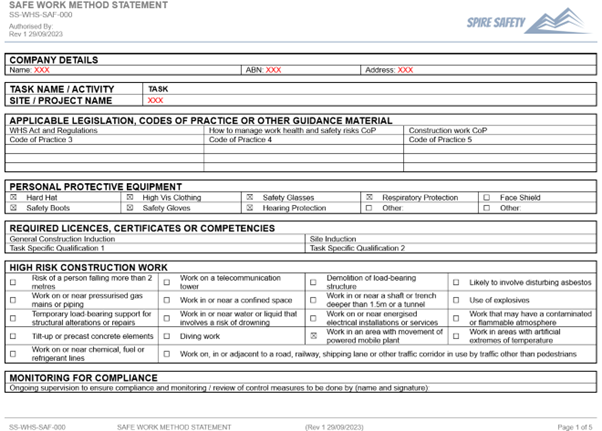Free Restorations SWMS (Safe Work Method Statement) Template
Download our free Restorations SWMS:
*For internal use only. Not for resale or redistribution. By downloading, you agree to our Free Resources Licensing Agreement.
Purpose of a Restorations SWMS
A Restorations SWMS is a document that identifies hazards and controls associated with restorations activities. SWMS also list how the control measures will be implemented, monitored, and reviewed.
How to Use a Restorations SWMS
This Restorations SWMS is a template only and must be customised for your business by a competent person in consultation with workers.
To complete the SWMS, fill in the details on the front page, including:
- Company details,
- Task, site and PPE details,
- Any relevant codes of practice, licenses and high risk construction work, and
- Person responsible for monitoring and ensuring compliance.
Ensure task-specific hazards and controls are added:

Other factors that need to be considered include, but are not limited to, ensuring that:
- Relevant legal requirements have been met,
- Workplace specific risks are identified and managed, and
- Workers are consulted with during the customisation / review process.
When to Use
Workers should read and agree to comply with the Restorations SWMS prior to operation within your business. It can also be used for refresher training and during the induction / onboarding process.
Who Should Use
Restorations SWMS should be developed by a competent person, in consultation with workers. The SWMS is then read and followed by the workers. New workers should also read and understand all applicable site / company SWMS during the induction or onboarding process.
Legal Considerations
Legally, businesses (or PCBUs) need to ensure a Safe Work Method Statement is completed prior to high-risk construction work commencing. The requirement for SWMS is outlined in:
- s(299) WHS Regulations – Safe Work Method Statements,
- s(300) WHS Regulations – Compliance with Safe Work Method Statements,
- s(301) WHS Regulations – SWMS Collection by Principal Contractor,
- s(302) WHS Regulations – Review of SWMS, abd
- s(303) WHS Regulations – SWMS Record Keeping.
A SWMS may also help to meet:
- s(19)(3)c WHS Act – Duty to Provide Safe Systems of Work.
Depending on the task being completed, the following legal requirements may apply:
- s(44 – 47) WHS Regulations – Personal Protective Equipment,
- s(49 – 50) WHS Regulations – Managing Risks from Airbourne Contaminants,
- s(51 – 52) WHS Regulations – Hazardous Atmospheres,
- s(54 – 55) WHS Regulations – Falling Objects,
- s(56 – 59) WHS Regulations – Noise,
- s(60 – 61) WHS Regulations – Hazardous Manual Tasks,
- s(62 – 77) WHS Regulations – Confined Spaces,
- s(78 – 80) WHS Regulations – Falls,
- s(81) WHS Regulations – High Risk Work (Licensing),
- Part 4.6 WHS Regulations – Demolition Work,
- Part 4.7 WHS Regulations – General Electrical Safety,
- Part 4.9 WHS Regulations – Crystalline Silica,
- Chapter 5 WHS Regulations – Plant and Structures,
- Chapter 6 WHS Regulations – Construction Work,
- Chapter 7 WHS Regulations – Hazardous Chemicals, and
- Chapter 8 WHS Regulations – Asbestos.
FAQ’s
What is High Risk Construction Work?
High risk construction work is defined in WHS Regulations s(291). Some common types of high risk construction work are:
- Working at heights over 2m,
- Working in a trench or excavation over 1.5m,
- Work with mobile plant,
- Work on or adjacent to a roadway, and
- Work in confined spaces.
For a full list of high risk construction work, read our article 18 High Risk Construction Work Activities.
What are Restorations?
Restorations in residential and commercial settings involve repairing and improving buildings to return them to their original or enhanced condition. This process can include fixing and repairing damage, updating plumbing and electrical systems, preserving historical features, or restoring buildings that have been affected by events such as water and fires.
What Hazards Are Involved in Restorations?
Some hazards that are involved in restorations include:
- Structural collapse,
- Asbestos exposure,
- Electricity,
- Fire,
- Chemical exposure,
- Falling debris,
- Noise,
- Mould,
- Slips, trips and falls,
- Water, and
- Confined spaces.
How Often Does a Restoration SWMS Need to be Reviewed?
SWMS should be reviewed to ensure safety controls remain effective after:
- The task or environment changes,
- New processes or systems are incorporated into the task, and / or
- Following incidents or safety alerts.
If the task or environmental conditions do not change, SWMS should be reviewed informally by workers prior to each job with a “formal” (documented) review at least yearly.
Did You Know?
The restoration of the Sistine Chapel ceiling was a monumental project that took 14 years to complete, from 1980 to 1994. The process involved meticulously cleaning and conserving Michelangelo’s iconic frescoes, revealing vibrant colours and intricate details that had been obscured for centuries under layers of grime, soot, and previous restoration attempts. This extensive effort not only restored the ceiling’s original beauty but also provided new insights into Michelangelo’s artistic techniques and vision.
Article Sources and Further Reading
- A Comprehensive Guide to Safe Work Method Statements (Spire Safety) <https://spiresafety.com.au/resources/safe-work-method-statements/>
- The Complete Guide to WHS Policies and Procedures in Australia (Spire Safety) <https://spiresafety.com.au/resources/guide-to-whs-policies-and-procedures/>
- Safe Work Method Statement for High Risk Construction Work (Safe Work Australia) <https://www.safeworkaustralia.gov.au/system/files/documents/1703/information-sheet-safe-work-method-statement.pdf>

